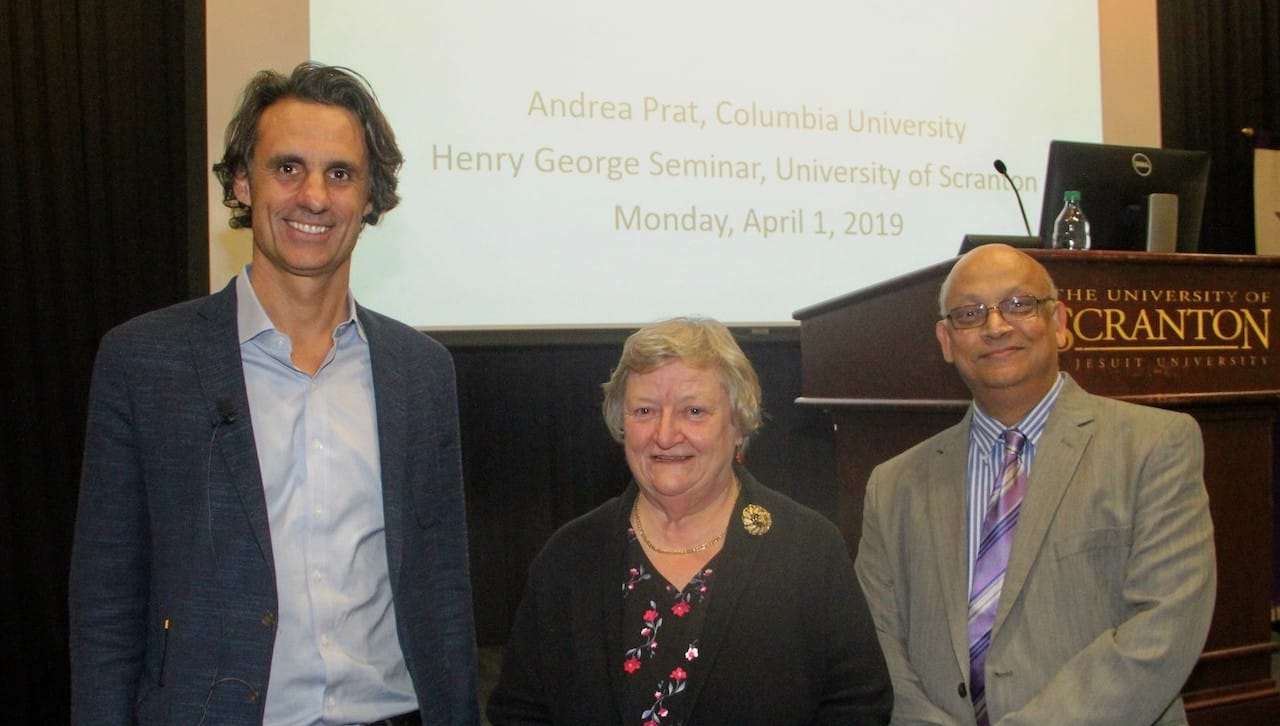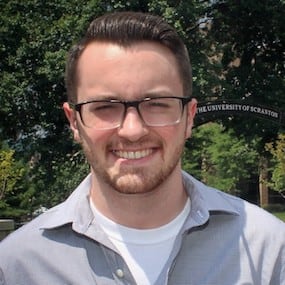Henry George Lecture Discusses Issues with Media

“In order to keep government accountable, voters need information. In modern democracy, this information comes from media,” said Andrea Prat, Ph.D., professor of economics from Columbia University, at The University of Scranton’s Henry George Seminar on campus. He discussed “Media Power: Measuring the Influence of News Media on Politics,” and noted that media includes “traditional platforms like newspapers and television, and new platforms like social media and the internet.”
In his lecture, Dr. Prat said the founding fathers of the United States were aware of the role media played in a democracy.
“Thomas Jefferson had the idea that the media is at the center of the democratic system,” Dr. Prat said, noting “in the past decade people have lost faith in the media.”
“The percentage of adult Americans who say they have little or no faith in newspapers, and it has gone from below 20 percent to twice as much,” said Dr. Prat
Dr. Prat discussed four issues that can negatively impact media’s role with the first problem being fake news.
“News should be impartial and informative and people say we are getting bias news or even completely fabricated news,” Dr. Prat said.
The second issue mentioned is when the media and the government join together.
“The media and the government are supposed to be separate in Thomas Jefferson’s view. They are supposed to be even adversarial, so the media should not be nice to government,” Dr. Prat said. “One thing that can go wrong is if the media becomes too crucial to government or to the opposition.”
The third issue is how there is little variety in the news media.
“The third thing that can go wrong is concentration,” Dr. Prat said. “We need morality with many voices and one potential risk people see is excessive concentration.”
The fourth issue is a financial concern with media outlets, where many companies are losing money.
“I will argue the revenues for commercial media have been dried out,” Dr. Prat said. “It’s becoming harder and harder to sustain the journalistic model we’ve had so far.”
In order to measure how important a news source is and how much attention is drawn to it, Dr. Prat would research the percentage of a population that use a single news source for information. In the U.S., the media outlet with the most attention is News Corporation, who owns Fox News.
“Why does Fox News have so much attention? Because many people watching only tend to watch Fox News,” Dr. Prat.
Dr. Prat based how informed people in the U.S. are on how many sources of news were used. How likely we are to have numerous sources is influenced age, gender, income, education and political outlook according to Dr. Prat.
“All of these create information inequality,” Dr. Prat said. “In our society, some people have many more sources than others. They choose to have many more sources and this is probably related to income and education.”
According to Dr. Prat, there is a correlation between income inequality and information inequality.
“If we put countries on this scatter plot, we see a positive correlation with countries with a lot of income inequality also tend to have a lot of information inequality,” Dr. Prat said. “The United States is a particularly high income inequality and information inequality country.”
Dr. Prat discussed media capture, where the government and the media begin working together, using stories from Peru, Britain and Italy to demonstrate this concept. He focused mostly on Italy because he said that began his interest in mass media.
In the 1990s Silvio Berlusconi ran for prime minister and he was, at the time, the owner of the largest commercial TV network.
“He got elected and got systematic positive coverage, unsurprisingly, from the TV stations he owned,” Dr. Prat said. “Now it is interesting how that allowed him to keep power.”
While Berlusconi was in power Italy’s economy fell with its GDP dropping.
“It’s interesting if you control the media, you can get re-elected even when your country is clearing underperforming,” Dr. Prat said.
He concluded the lecture with his revenue model, with how revenue is dropping with journalists due to a loss of advertising. According to Dr. Prat, media outlets with a subscription service are doing very well, for example The New York Times.
“But this goes back to the information inequality we were talking about and the majority of people don’t use those sources because they’re behind a pay wall,” Dr. Prat said.
The spring Henry George Seminar is presented by the University’s Economics and Finance Department and the campus chapter of Omicron Delta Epsilon, an international honor society for economics. It was named in honor of the 19th century American economist and social reformer. The lecture series is supported financially by a grant from the Robert Schalkenbach Foundation.







